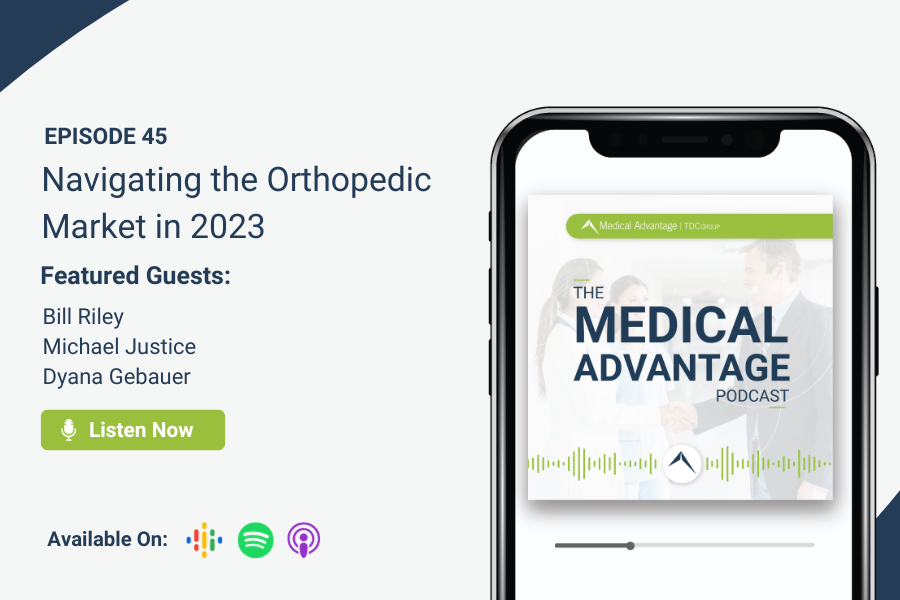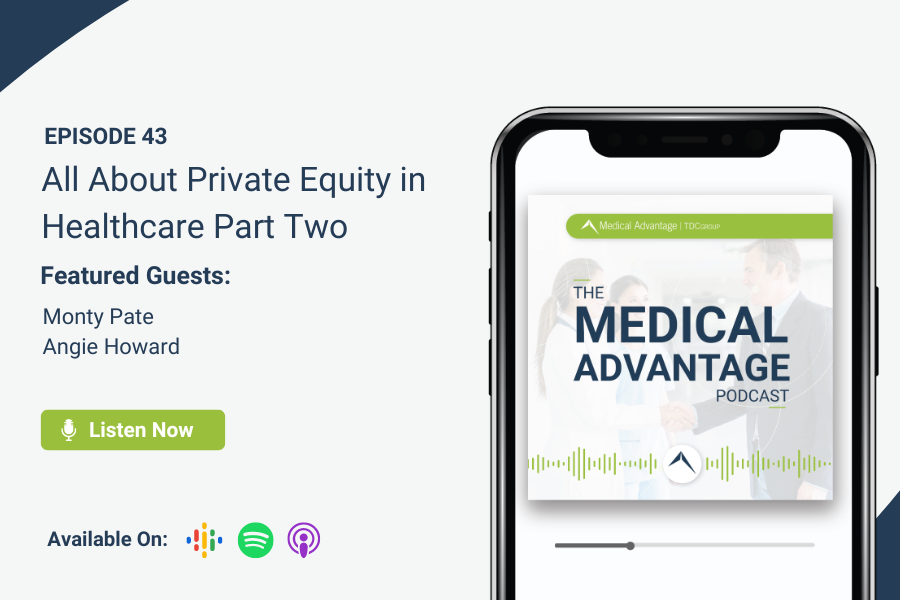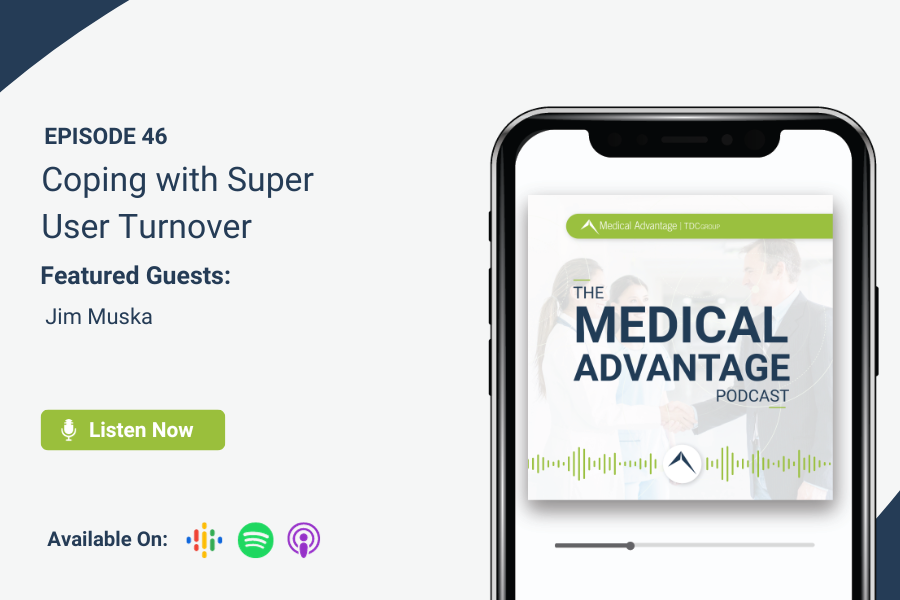Join us for an enlightening discussion of the big trends in orthopedic marketing. In this candid conversation, our panel delves into the ever-evolving world of orthopedics, bringing into focus the current landscape of this dynamic area of healthcare.
Moderated by Vice President of Marketing Bill Riley, we’ll outline the key transformations unfolding before our eyes in the orthopedic world and how those tie to digital marketing strategy.
Despite the whirlwind of transformation, the pivotal role of online healthcare marketing remains its foothold, but not without adaptably to navigate the shifting industry landscape. Executive Consultant Michael Justice and Campaigns Manager Dyana Gebauer provide firsthand insights into the major players in the orthopedic market and what it takes to thrive. Their practical approach to digital marketing applies to an array of orthopedic subspecialties.
Get insider knowledge on what is happening right now in the orthopedic market. Armed with this knowledge, you’ll be well-equipped to make critical business decisions and chart a course for what’s next.
Thank you for listening to the Medical Advantage Podcast, where each we take time each episode to discuss the ideas and technologies changing healthcare, and the best practices your organization can take to stay productive and profitable. Subscribe wherever you get your podcasts to ensure you never miss an episode.
Contact Our Team Today
Full Episode Transcript
Medical Advantage Podcast: Welcome to the Medical Advantage podcast, where you can hear healthcare professionals, expert consultants, and industry thought leaders discuss the exciting new ideas and technologies that are changing the business of healthcare. Tune in to each episode as we hear from some of the most innovative minds in medicine about the future of healthcare and how your organization can stay profitable, efficient, and on top of industry best practices.
Rebekah Duke: Hello, and welcome back to the Medical Advantage podcast. This is Rebekah Duke, here to introduce another episode about healthcare digital marketing. Our vice president of marketing, Bill Riley recently moderated a panel discussion all about the current landscape of digital marketing for orthopedic practices.
It has been a transformative time for orthopedic specialists to say the least. And we’re here to get you up to speed on what digital marketing can do to help leaders respond to current shifts and trends in the market. Our subject matter experts for this presentation are Dyana Gebauer, who oversees our client digital ad campaigns, and Michael Justice, who is a top strategist for healthcare business growth, each having a firm grasp of what orthopedic practices need to do to thrive in the digital space in the here and now. So let’s drop in on the conversation.
Bill Riley: Thank you all for joining us today. Our view, 2023, and the view into the orthopedics market from a couple of different vantage points. My name is Bill Riley. I’m the marketing leader at Medical Advantage and on behalf of our panelists, Michael and Dyana, thank you for joining us today.
Before we dive in, let me do a quick commercial, quick summary of Medical Advantage. The work we do, the clients we serve. We’re a healthcare consulting company at our core. We’re supporting ambulatory practices and large groups, including specialties such as ortho and foot and ankle, whether they’re independent or private equity backed, ultimately, we’re helping to drive performance in their reimbursement relationships, in their value based care arrangements.
That’s our overall umbrella whether it’s helping with cost and quality metric performance improvements, analytics, and reporting, improving the use of in-practice technology, starting with the EHR platform, whether that’s optimizing the platform, providing staff training, supporting go-lives, et cetera.
And then through a fairly recent acquisition of a digital marketing agency, iHealthSpot, we provide a broad range of practice marketing services to help our clients engage new patients, drive appointment volumes and grow overall practice revenue. Medical Advantage is a subsidiary of TDC group, which also includes The Doctor’s Company which is the largest physician owned med mal insurer in the country with close to 90,000 insured members.
So with that, let’s introduce our panelists, Michael, why don’t you go first, tell us a little bit about who we are and your role here at Medical Advantage.
Michael Justice: Thanks Bill. My name is Michael Justice. I’m an executive consultant with Medical Advantage. I have over 30 years of experience in healthcare and a variety of executive roles, including marketing technology and revenue cycle management.
A lot of my efforts as a consultant are dedicated to helping integrate groups that are consolidating. Both independent and equity backed. This involves technology, process and change management for those groups.
Bill Riley: Okay, very good. Dyana, same for you. A little, your background and your role here.
Dyana Gebauer: Yeah, thanks, Bill.
I’m Dyana Gabauer and I’m a manager of client success here at iHealthSpot. I’m in my 16th year with Medical Advantage Company. I spent a number of years early on in practices working in value-based care arrangements and quality improvement activating change that we need to see inside of practices to do well in risk contracting, really things that impact peer arrangements, patient retention and current patient strategies.
And today, now I work to ensure that customers have the strategies and services to focus on new patient acquisition through growth and marketing. We realize there’s an overload of information and complexity in health care, and we really strive to put very thoughtful and concise set of changes and services together to help practices be successful and marketing is just one of those tools that we use today.
Bill Riley: Great. So I think between the 2 of you, Michael, my view of your work is sort of tops down, seeing the bigger trends that are happening with the larger organizations that you’re supporting. Dyana, you’re kind of bottoms up, like you’re at the ground level with your practices, supporting them day to day, week over week, you know, doing whatever, helping them to do whatever is needed to be successful.
So thank you both for being here. So, Michael, why don’t we start with you with big picture? A lot is happening in the orthopedic specialty from your vantage point. What are some of the things that you’re seeing?
Michael Justice: Well, there’s a lot of change in the specialty, you know, one of the constants in health care in general is change. And this is certainly true in the orthopedic specialty, a number of orthopedic groups are getting bigger. Solo practices quickly disappearing, roughly a 50 percent decrease between 2012 and 2020. Specialization within the practices is also a major shift. Less generalist, more specific hand surgeons, shoulder surgeons, knee surgeons, et cetera.
The expanded use of APPs and the shift to outpatient procedures using ASCs and day surgery for procedures that historically were all done inpatient.
Bill Riley: Very good. And Dyana, same question. What are some of the things that you’re seeing as you support your clients?
Dyana Gebauer: Yeah, it’s very similar. And a lot of our orthopedic practices are essentially at their core multi-location.
But many now have that very unique subspecialty that they’re bringing in like foot and ankle or physical therapy. Urgent care is another one we’re seeing a lot of. So with marketing, we really have to understand those unique makeups to drive an approach that works. And for orthopedic practices, I see trends around this consolidation.
So understanding what that consolidation means, what the branding is that they’re looking at and all of that really means more than just the typical SEO or pay per click that strategy that, that some folks have been used to. We really look deeper and we have to understand the analytics of a practice and a region.
So we have data sets where we look at their market share, their referral drivers whether that’s a PE backed group or a solo multi-location practice. Our work is really to make those groups successful and getting more patient appointment books regardless of their structure.
Bill Riley: Great. I want to pick up on something you just said there.
You mentioned urgent care locations. I want to just talk a little bit more about that because I think it’s something that we’re, we’re seeing more and more of as parents, each of us you know, I’m sure we’ve all had the opportunity to be in rather urgent need of ortho support. Can you talk a little bit about what some of the engagements you’ve been in and the kinds of work you’ve done?
Dyana Gebauer: Yeah, so whether it’s urgent care or typical orthopedic needs, we have to understand how patients find their way to a practice. What are their drivers? Are patients starting with the near me local search terms by condition? Are they looking by insurance type? Are they wanting the best orthopedist in terms of reviews that they search for?
So there’s a lot of different strategies by client and by structure. But one successful channel we’ve seen is Google Ads. So using social ads with ortho is, is kind of like cold calling your audience where you know, you’re targeting potential shared interest points on social but it’s people who are unfamiliar with your brand.
So, you know, you might be hoping that ad sticks in someone’s brain. So when your athlete on a Friday night football under the lights breaks an ankle, you’re hoping that mom remembers the ad. But really we all know Google is king and Google Ads tend to address people further down the funnel who are intentionally searching for your practice rather than just presenting them an ad for your clinic and hoping they remember you when they need you.
So there’s specific strategies based on the structure type of the practice. We had one group who just over a year in implementing their Google Ads had over 100 percent increase on their clicks and 300 percent increase on conversions through some of the strategies we deployed for their urgent care.
So there’s, there’s definitely a way to think through that to help practices, depending on their type.
Bill Riley: Excellent. Excellent. Okay. Speaking of location types, Michael, I’d like to come back to something you mentioned it right up at the beginning. And that’s the growth of ASC’s. Can you share give us a little more color?
Michael Justice: I can. ASCs or ambulatory surgical centers were part of the ambulatory part of the ortho world prior to 2017, but not to the degree they are now. Total knee replacements decreased from a hundred percent in hospital to 25% between 2017 and today. Inpatient total HIPs are now 37 percent of what they were in 2017.
All of this is gone from 100 percent in house, or very close to it, to the vast majority being done in ambulatory surgical centers. Why did this happen? First off, CMS changed the procedures from inpatient only to the availability of outpatient in a hospital or an ambulatory surgical center. Prior to 2018, Medicare would only pay if the surgery was done in an inpatient setting.
COVID hit. COVID created challenges with hospitals being able to operate their operating suites. Because of schedule issues with staff infections and staffing problems in general, orthopedic surgeons move their surgeries to ASCs, that was the catalyst or risk the cancellations and reduced revenue and increased patient suffering.
That’s what got it going. It’s never gone back. There was a little blip as COVID dissipated, but it is totally moved towards the ambulatory surgical center. From the surgeon’s perspective, ASCs are smaller. They’re more tailored to the surgeon’s preference. Surgeons have a lot more input into the supplies on hand, the equipment, and everything is convenient and efficient for the surgeon.
Commercial insurance likes this trend because of the lower operating costs of the ASCs, the cost of the facility portion of the procedure is significantly less. Oftentimes, half of the procedure being done In a hospital, patients oftentimes enjoy a more curated experience of the ASCs. It’s not part of a big hospital, everything from more convenient parking to a more friendly staff.
There’s lower infection rates today, versus hospital surgeries. Oftentimes ASCs will reschedule patients where a hospital would bring them in for the surgery. The other note here with ASCs, just over half of them are owned by physician groups. There are a number of large operators of ASCs. Tenant health care is one of the largest.
Other shifts, APPs. Nurse practitioners, physician assistants are increasing in numbers in the orthopedic specialty. Their role is dependent on the state and the practice and the physicians in that in the group, but it’s growing basically to remove some of the tasks that are currently done by physicians.
So those physicians can see more patients in the OR. Value based care is also a huge deal, bundled packages. And the lower operating costs at ASC are a perfect combination in value-based care.
Bill Riley: Okay, very good. Thank you. I’ll ask another sort of general question to both of you. Dyana, maybe we can start with you this time.
As you look at the work you’re doing day to day, you and your team supporting our orthopedic specialties, including foot and ankle clients with their practice marketing needs based on what you’re seeing in our market today and ways where you’ve helped to make your client successful. What is the advice you would give to a prospective orthopedic specialty?
Dyana Gebauer: Yeah, we realize practices are facing a lot of change in their structure and they live with a dozen different payer requirements. The same amount of technology systems, and we don’t want to add to that burden of what they’re already trying to accomplish in their practice. So we focus on fundamental marketing strategies, but with the understanding that comes from having more than 25 years in health care as Medical Advantage does, so I’d say a practice’s website and their Google Business Profile are critical. Having a robust website is a prerequisite to any marketing. So ensuring it has the right technical specifications, the right content, the right user experience are key to achieving visibility on Google. And then being drivers that move patients into converting or requesting an appointment.
So I think that local search is really important and patient behavior so that when they find your practice, it’s a seamless experience, very clear treatment details on your website, clear button clicks, easy form fills, you know, when a patient finds your Google Business Profile, you want them to want to have spent time building a reputation there, too.
So, sporadically requesting reviews, maybe getting 50 in a three-month period and then doing nothing for a while isn’t the approach you want to take. Having a consistent even EHR integrated review request strategy that grows your reputation consistently is critically important to local search which is the market you’re really trying to reach as a provider in a specific area.
So well structured Google Business Profile, well thought out website are I think really important to new patient bookings.
Bill Riley: Great. Great. Okay. Michael, same question to you. What is your free advice to orthopedic practices?
Michael Justice: Certainly, I would say what Dyana said is spot on. You want to have your presence known in the community. And when folks go to your website, you want the website to actually offer value. Folks contemplating a procedure, they want to research it and understand it. Best place to do that is your website, not just miscellaneous information on the web in the practice itself, whether you’re an independent practice or an equity backed practice.
Optimization is the key. This includes the administrative and the clinical aspects of the practice. Objective measures to illustrate outcomes are important more than ever. Patient engagement is huge in keeping patients satisfied and informed. Optimization is key. Use the combination of people, process, and technology to your advantage and to your patient’s advantage.
Bill Riley: Okay, great. I think that wraps us up for today. Short and sweet, concise to the point. And with that, I’ll say to you, our audience, thank you for joining us. First of all, Michael, Dyana, great job, as always. And to our audience, thanks for joining. We hope you found some ideas or insights from our brief session today. And we hope to see you again at another Medical Advantage webinar in the future. Thank you.
Rebekah Duke: And this concludes our presentation for today. Thank you audience member for joining us for this episode. Should you have any questions in general or for our panelists, please email us at info@medicaladvantage.com. You can also visit our website at medicaladvantage.com for more information about healthcare operations strategy, including practice marketing.
For Industry Insider Insights, you probably won’t hear anywhere else, subscribe to our channel wherever you get your podcasts and opt in for notifications. Hope to have you back for our next episode coming soon.
Medical Advantage Podcast: Thanks for joining us this week on the Medical Advantage Podcast where we discuss the ideas and technologies changing healthcare and what they mean to your organization. For more information, visit us at medicaladvantage.com and make sure to subscribe to the podcast on iTunes, Spotify, or wherever you get your podcast, so you never miss a show.




